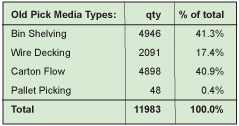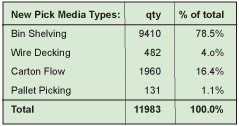A company recently completed an analysis of its pick location sizes and estimated that it could dramatically cut its labor costs.
Its distribution center was filled entirely with reserve racking.
Pick locations were at the bottom level of the reserve rack and were primarily constructed of carton flow, bin shelving, and wire deck locations.

Completion of the pick-face analysis determined the warehouse had far too many slow cubic velocity SKUs in large pick locations – primarily carton flow locations. The analysis determined that a more efficient set-up included a near doubling of bin shelving and a reduction in carton flow and wire deck locations.

Moving the slow cubic velocity product to bin shelving significantly decreased pickers’ travel times and freed up some warehouse space.
Moving the customer’s high-velocity product into pallet locations and carton flow dramatically reduced the amount of replenishments required throughout the day. The result was a 38% reduction in picking personnel and just over a 20% reduction in replenishment personnel due to many of the aforementioned efficiency factors associated with the proper sizing of pick media.
This sort of pick-face sizing analysis works well for DCs that have a single pick location for each SKU.
DCs having separate picking areas for cases and units need a slightly more complex algorithm for determining appropriate sizing of case pick and each pick locations.
Nonetheless, it is possible to gain equal efficiency improvements under both scenarios.
Additionally, robust software programs exist to help simplify the process.
Dale Barbee is a vice president with Brentwood, TN-based supply chain consultancy Fortna. Charley Johnston is a senior process improvement engineer.
